
A tower block, high-rise, apartment tower, residential tower, apartment block, block of flats, or office tower is a tall building, as opposed to a low-rise building and is defined differently in terms of height depending on the jurisdiction. It is used as a residential, office building, or other functions including hotel, retail, or with multiple purposes combined. Residential high-rise buildings are also known in some varieties of English, such as British English, as tower blocks and may be referred to as MDUs, standing for multi-dwelling units. A very tall high-rise building is referred to as a skyscraper.
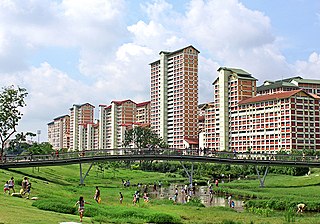
Public housing is a form of housing tenure in which the property is usually owned by a government authority, either central or local. Although the common goal of public housing is to provide affordable housing, the details, terminology, definitions of poverty, and other criteria for allocation vary within different contexts.

An apartment, or flat, is a self-contained housing unit that occupies part of a building, generally on a single story. There are many names for these overall buildings, see below. The housing tenure of apartments also varies considerably, from large-scale public housing, to owner occupancy within what is legally a condominium, to tenants renting from a private landlord.

A housing estate is a group of homes and other buildings built together as a single development. The exact form may vary from country to country.
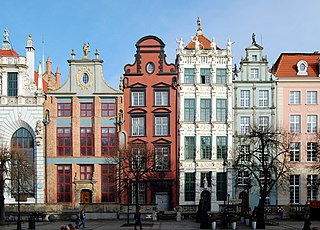
A townhouse, townhome, town house, or town home, is a type of terraced housing. A modern townhouse is often one with a small footprint on multiple floors. In a different British usage, the term originally referred to any type of city residence of someone whose main or largest residence was a country house.
A condominium is an ownership structure whereby a building is divided into several units that are each separately owned, surrounded by common areas that are jointly owned. The term can be applied to the building or complex itself, as well as each individual unit within. The term "condominium" is mostly used in the USA and Canada, but similar arrangements are used in many other countries.

A household consists of two or more persons who live in the same dwelling. It may be of a single family or another type of person group. The household is the basic unit of analysis in many social, microeconomic and government models, and is important to economics and inheritance.

A stand-alone house is a free-standing residential building. It is sometimes referred to as a single-family home, as opposed to a multi-family residential dwelling.

A duplex house plan has two living units attached to each other, either next to each other as townhouses, condominiums or above each other like apartments. By contrast, a building comprising two attached units on two distinct properties is typically considered semi-detached or twin homes but is also called a duplex in parts of the Northeastern United States, Western Canada, and Saudi Arabia.
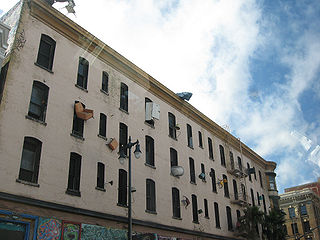
Single room occupancy is a form of housing that is typically aimed at residents with low or minimal incomes who rent small, furnished single rooms with a bed, chair, and sometimes a small desk. SRO units are rented out as permanent residence and/or primary residence to individuals, within a multi-tenant building where tenants share a kitchen, toilets or bathrooms. SRO units range from 7 to 13 square metres. In some instances, contemporary units may have a small refrigerator, microwave, or sink.

Housing in Japan includes modern and traditional styles. Two patterns of residences are predominant in contemporary Japan: the single-family detached house and the multiple-unit building, either owned by an individual or corporation and rented as apartments to tenants, or owned by occupants. Additional kinds of housing, especially for unmarried people, include boarding houses, dormitories, and barracks.
Housing in Portugal is generally similar to housing in the rest of Europe. However, some specificities exist. Portugal has the highest rate of rural population in Western Europe, which means that roughly a third of the Portuguese families live in farms or properties outside urban areas. Another characteristic is that most of the urban population is actually suburban. The metropolitan areas of Lisbon and Porto each have over 2 million inhabitants. In these areas, families live in apartment blocs, each apartment usually having two bedrooms, a living room, a kitchen and one or two bathrooms.

Home construction or residential construction is the process of constructing a house, apartment building, or similar residential building generally referred to as a 'home' when giving consideration to the people who might now or someday reside there. Beginning with simple pre-historic shelters, home construction techniques have evolved to produce the vast multitude of living accommodations available today. Different levels of wealth and power have warranted various sizes, luxuries, and even defenses in a "home". Environmental considerations and cultural influences have created an immensely diverse collection of architectural styles, creating a wide array of possible structures for homes.
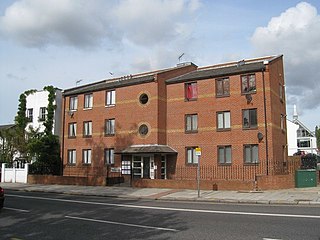
Multifamily residential is a classification of housing where multiple separate housing units for residential inhabitants are contained within one building or several buildings within one complex. Units can be next to each other, or stacked on top of each other. A common form is an apartment building. Many intentional communities incorporate multifamily residences, such as in cohousing projects. Sometimes units in a multifamily residential building are condominiums, where typically the units are owned individually rather than leased from a single apartment building owner.

A housing unit, or dwelling unit, is a structure or the part of a structure or the space that is used as a home, residence, or sleeping place by one person or more people who maintain a common household.

The Boulevard Gardens Apartments is a 960-unit apartment complex at 54th Street and 31st Avenue in Woodside, Queens, New York City. It opened in June 1935, during the Great Depression. They were designed by architect Theodore H. Englehardt for the Cord Meyer Development Corporation; the design was based on an apartment complex Elgelhardt designed in Forest Hills.
The Golden Triangle is one of the largest retail districts in New England and is located on the borders of Framingham and Natick, Massachusetts, in the heart of the MetroWest region of the state. The district is anchored by the two malls in the area, Shopper's World and the Natick Mall. The 3 sq mi (7.8 km2) area is the second largest shopping district in Massachusetts outside of Downtown Crossing in Boston.
Real estate is property consisting of land and the buildings on it, along with its natural resources such as crops, minerals or water; immovable property of this nature; an interest vested in this (also) an item of real property, buildings or housing in general. In terms of law, real is in relation to land property and is different from personal property while estate means the "interest" a person has in that land property.
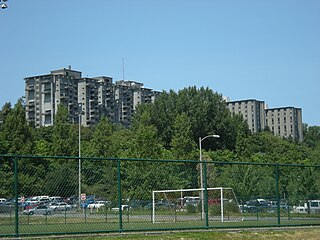
Housing at the University of Washington is administered by the Housing & Food Services (HFS) department at the University of Washington. Undergraduates are housed primarily in residence halls located on North Campus and West Campus. Typically, residence halls are 9-month spaces for undergraduate students. However, there are also 12-month apartment spaces available for undergraduate students. Graduate and professional students are provided the option to live in 12-month apartments operated either by the university or privately. The University of Washington does not require students to live on campus. Although students are not required, about 71% of freshmen choose to live on campus. Housing is not guaranteed but placement in the residence halls is guaranteed for returning residents. Most winter quarter and spring quarter applicants are assigned housing. There are also three family housing options for registered full-time students at the Seattle campus.
















